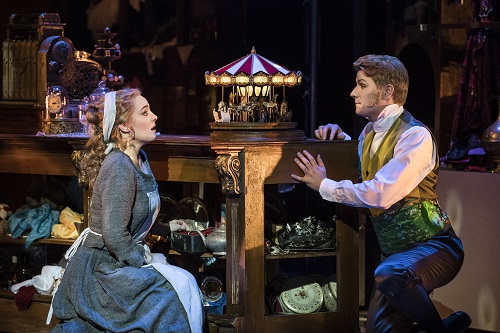 Sweden Rossini, La Cenerentola: Soloists, Male Chorus and Orchestra of the Royal Swedish Opera, Stockholm, Jean-Christophe Spinosi (conductor). Royal Swedish Opera, Stockholm, 25.11.2017. (GF)
Sweden Rossini, La Cenerentola: Soloists, Male Chorus and Orchestra of the Royal Swedish Opera, Stockholm, Jean-Christophe Spinosi (conductor). Royal Swedish Opera, Stockholm, 25.11.2017. (GF)

Production:
Direction – Lindy Hume
Sets, Costumes & Masks – Dan Potra
Lighting Design – Matthew Marshall
Cast:
Angelina (La Cenerentola) – Johanna Rudström
Clorinda – Marianne Hellgren Staykov
Tisbe – Karin Osbeck
Don Ramiro – Ole Aleksander Bang
Dandini – Jens Persson
Don Magnifico – John Erik Eleby
Alidoro – Markus Schwartz
As in the spectacular Dracula at the Royal Opera four weeks ago (review click here), sets, costumes and masks were the work of Dan Potra in this Cenerentola, and spectacular it was again – although quite different from the horror atmosphere of Bram Stoker’s vampire work. Here Perrault’s old fairy tale with Rossini’s congenial music is set in nineteenth-century Anglo-Saxon milieu, Union Jacks are waving in all possible and impossible situations, the backdrop in the first scene is a Victorian style wall filled with books, Don Magnifico’s house looks like something out of a Dickens novel and the Royal Castle garden is a brightly coloured illustration from a children’s book. The allusions to Britain are easily explained. The stage director is Australian and this production was originally made to order by Opera Queensland and New Zealand opera. Another interesting fact is that La Cenerentola was the very first opera performed in Australia – the opening night took place shortly after the wedding of Queen Victoria and Prince Albert in 1840. Stockholm’s previous Cenerentola, premiered in May 2008, was set in the present time, Don Magnifico ran a shabby bar in New York, while the Prince had a super-fashionable design flat with two big glass shoes in the background – a nod to 1950’s Disney movies. The costumes for the current production are fanciful and luxurious – apart from Don Magnifico’s tawdry outfit – but the dress Angelina wears when she goes to the ball at the castle is very Disney-esque.
The comedy fizzes along elegantly and with excellent timing, the gags are inoffensive – bar the stepsisters’ and Don Magnifico’s, of course. The noble and strict John Erik Eleby creates a Don Magnifico surpassing anything I have seen in terms of nastiness. In the midst of the sometimes chaotic occurrences, Angelina is coolness personified, and the message of her final aria – forgiveness instead of revenge – is particularly valuable in these times social media mobbing. One cannot help feeling elated at the sight of this bullied and degraded young woman standing there in front of the castle, with her prince up on the balcony looking down at her tender-heartedly.
Generally speaking, director Lindy Hume has done a marvellous job in creating interesting personalities out of the characters. The male members of the opera chorus also have much to do, in various disguises, not least when four of its largest members are dressed in female outfits – and all four are heavily bearded! The soloists belong to the youngest generation of the ensemble – with the exception of veteran bass-baritone John Erik Eleby as Don Magnifico in characteristically splendid vocal form. And the terrific visual and theatrical parody of the conceited lout is truly magnifico. Marianne Hellgren Staykov and Karin Osbeck are as ingratiatingly nasty as the two step-sisters. Markus Schwartz’s Alidoro, the fairy of the story, is noble and dignified – and sings well. Dandini, the butler turned prince and turned butler again, is lively and expressively impersonated by the lanky Jens Persson – he is a born comedian and gifted singer. Ole Aleksander Bang makes his debut at the Royal Opera in the difficult role of Prince Ramiro. It is a bel canto role that requires solid technique, flexibility and aptness for coloratura, which he has. It also requires him to sing some ringing high Cs – which he has, with knobs on. But what impressed me even more was his outstanding acting. He is elegant, expressive and has comic talent as well. And having previously trained as a dancer, he has complete control over his body. Johanna Rudström, the Cenerentola – Angelina of the production, has made her mark during the past few years, primarily in smaller roles, although she recently appeared as Cherubino in Le nozze di Figaro. Her Cenerentola was a success in every respect, touching, vulnerable but also filled with hope and, when she appears at the castle and nobody recognises her, full of joie de vivre. Her voice is not of the biggest, but it is beautiful, well balanced and brilliant when needed. She is scheduled to sing Olga in the new Eugene Onegin in April 2018. Something to look forward to.
The Royal Orchestra under Rossini specialist Jean-Christophe Spinosi play excellently. The previous Cenerentola was a great success, this new version is very different – but just as good. The standing ovation was proof that others share my enthusiasm.
Göran Forsling